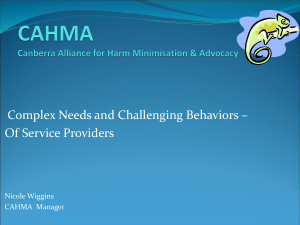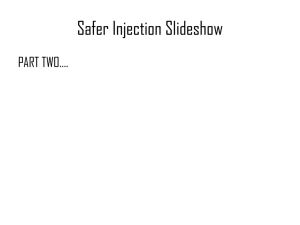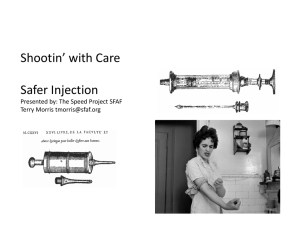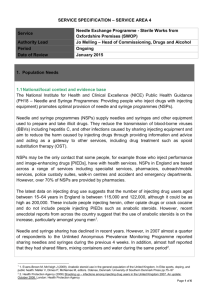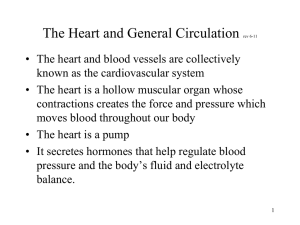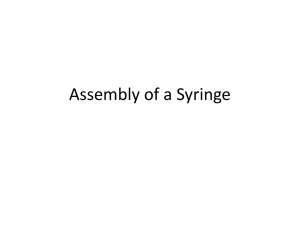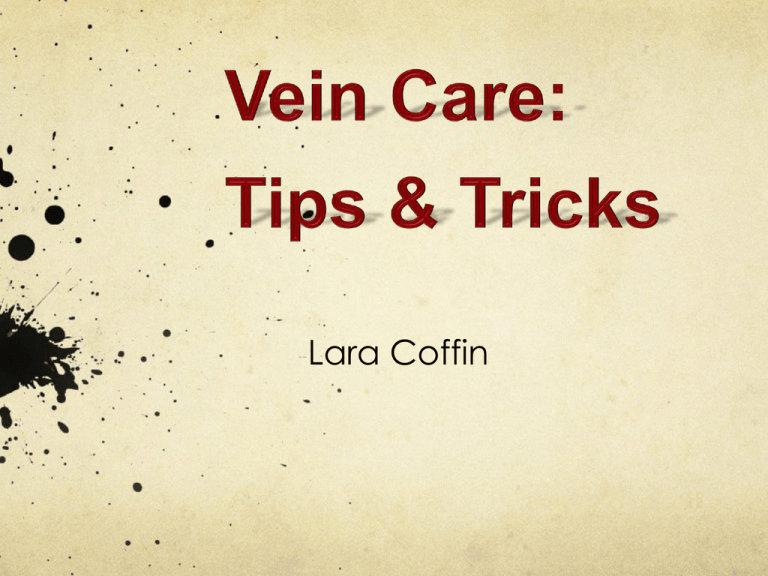
Lara Coffin
If you are alive
you have veins
When working with a person, ask questions to get a shapshot of them.
Don’t assume anything, like even if they feel comfortable reading
Quickly examine the person with NO judgment. Make a mental note
of special considerations, like:
•
•
•
•
•
Large person
Only has use of one arm
Lots of abscesses
Has a job and needs to hide track marks
Dehydrated
Homeless or sleeps outdoors
•
•
•
doesn’t have good light
access to running water
can’t keep tons of supplies on them so may need to reuse needles
Swollen ”cabbage patch kids” hands
•
Very bad circulation
Dried blood on shirt or arms
•
•
•
not good with cleaning
Use alcohol wipes?
hurry
Drugs people inject
Heroin
Methamphetamine
Cocaine
Crack – add acid
Methadone – use 3cc syringes
Pharmaceuticals (pills)
•
•
•
Lots of fillers
Outer coating
New formulations that gel up when try to inject
Steroid - muscle only
Multi-drugs (speedball)
TIP: Know the street slang for drugs. If you don’t know what
something is, however, don’t pretend you do. Ask them.
Routes of administration
Intravenous (IV): into a vein, 45°
Intramuscular (IM): into a muscle, 90°
Subcutaneous (SC): under the skin or “skinpopping”
Where to inject? That is the question.
Arms: first upper than lower
Hands: veins are smaller so use a smaller gauge,
rollers
Legs: circulation issues can lead to blood clots or
dvt’s
Feet: smaller veins, close to tendons and nerves.
Risk of infection and far away from the heart
Groin: Blind shot. Risky because of artery & nerve
Neck: Risky because it is right next to the artery that carries blood to the brain
Other: breast, penis, chest – all bad ideas because poor circulation or erection
problems
Tip: Always shoot towards the heart
Slide courtesy of Mary Howe
TIP: Sometimes it is impossible to inject toward
the heart without help from a friend, like
back of arm. In those cases, advise them to
inject the way that is steadiest (remember
this is harm reduction).
In this case:
•
•
•
water down hit
inject s-l-o-w-l-y
pull out if it stings or hurts
VEINS, ARTERIES, NERVES…. OH MY
Arteries
•
•
•
•
Carry oxygenated blood from the lungs and heart to other parts of
the body
Have a pulse
Blood in them is bright red and frothy
Deeper in the body than veins
Veins
•
•
•
Blood vessels that carry blood from the extremities of the body back
to the heart and lungs
No pulse
Blood is a deep, dark red because it is low in oxygen
Nerves
•
•
•
Not visible from outside the body
Will definitely know if you've hit one - experience extreme pain and no
blood when register
Dangerous because could result in paralysis or the loss of a limb.
Slide courtesy of Mary Howe
Valves
• Veins contain valves to prevent the
backflow of blood. Hitting a valve
can cause irreparable damage to
the vein leading to vein collapse or
varicose veins.
• To find the valve press your finger on
the vein and run it slowly down its
length. You should see a point
where blood stops (i.e, the vein
appears to stop as your finger
passes that point). When you lift
your finger, blood should flow again
past that point. That point contains
a valve so leave it alone.
• Sometimes looks like a little pea under
skin
Slide Courtesy of Mary Howe
Getting to know syringes
Gauge = thickness of the needle
The higher the gauge, the thinner the needle. For example,
a 31G needle is thinner than a 28G needle.
Tip: Using the best syringe for the job will do the least
amount of damage! Often people don’t know they are
better syringes out there for their situation
Specialty Syringes
31 gauge 5/16”
Great for hands and feet and tiny veins
that get blown out easily, but clog
29 gauge 1/2” ½ or 1cc
Good for folks who have smaller veins
Standard Syringes
28 gauge 1/2” 1cc (shorts)
The standard. It is good for people with good veins
(not long term west coast heroin users)
28 gauge 1/2” 1/2cc (halves)
These have the same needle as the shorts but their
barrels are ½ cc meaning they hold half the volume
27 gauge 5/8” 1 cc (longs)
The needle on it is slightly longer and the gauge is
slightly larger. These are ideal for deeper or scarred
veins.
Slide courtesy of Mary Howe
Muscle Syringes
LITTLE musclers: 25 gauge 1” 3cc
This is the standard syringe for muscling.
BIG musclers: 23 gauge 1 ½ ” 3cc
These are the standard syringe for larger folks and
people injecting hormones.
Tip: Lots of abscesses? Maybe not getting deep
enough in the muscle, scared to use the muscling
syringes or injecting near old abscesses
Muscling
(opiates, hormones & steroids only)
•Filter well, because high risk of abscess!
•Use at least a 1” needle
•Add a lot of water
•Insert the needle at a 90° angle
•Draw plunger back slightly to make sure no
blood enters syringe. If blood appears, pull
out and try again
•Inject slowly
Booty Bumping
Musclers are great for booty bumping because the
needle is detachable
•Draw up drug in a syringe barrel (take the needle off)
and squirt it up there.
•The anus has a lot of blood vessels that quickly absorb
the solution
•Will work almost as quickly as IV injecting and faster
than muscling, but there is no rush.
•It reduces risks associated with injecting including vein
damage, abscesses and overdose.
Tip: Women are much more receptive to this technique
then men, although MSM men are open to it also.
Slide courtesy of Mary Howe
Tourniquets & Ties…
• Use a slip knot, so the tourniquet
can slip off (there is an art to tying
your own tourniquet)
•When working with folks don’t keep
tourniquet on one site more than 1-2
min
•It is best to untie tourniquet before
injecting so don’t put extra pressure
on veins.
BUT…
If untying tourniquet will cause more
harm (i.e. pulling needle out or
deeper in), don’t do it.
Femoral
•
Need 1 - 1 ½ “ needle
•
Fixed to the barrel is best
to
keep the needle from
breaking off
•
Always wash the site
•
Sinus track
Tip: NAVY – Nerve, Artery, Vein, Your crotch
Find the femoral PULSE
Gently put the middle finger of your right hand on the pulse. (if
injecting into your left groin, use the left hand)
Let your index finger rest beside the middle finger.
The vein should be below the index finger.
Insert the needle next to the index finger pushing the needle in
straight (at about a 90 degree angle to the leg).
Register, inject and remove needleUse the clean towel or tissue
to stop the bleeding. Press on the injection site for at least a
minute then check to see if the bleeding has stopped or
reduced.
Keep the area clean after injecting.
Oh shit I hit an artery
I know this because….
• The plunger is forced back by the pressure of the blood
• Blood is bright red, frothy, and gushing.
• It hurts and burns
• Hand/foot blows up (Go to ER to get rings off!)
I should…
• Untie the tourniquet and pull the needle out
• Raise the limb above heart to stop the bleeding
• Apply pressure to the wound for at least 10 min
• If bleeding continues seek medical attention
immediately
TIP: When in doubt pull out!!
Slide courtesy of Mary Howe
Vein saving tips –
the usual suspects
Rotate your injection sites
Drink lots of water
Don’t smoke before injecting
Exercise
Warm compresses or heating pad
Take tie off before injecting
Inject slowly
Inject towards heart
Other Tricks to make veins last
Clean hands also with soap/water or
alcohol wipe
Let alcohol dry
Alcohol pads before not after
Use new needle whenever possible
Bevel up
Use the best syringe for the job
Water down hit (especially important if
injecting something corrosive, like
ascorbic acid)
Don’t bend needle with pressure when injecting
– break off in body and/or destroys veins
Don’t “roto rooter” rolling veins
It is easy to puncture through veins or pull out a
bit while injecting. Sit down. TAKE YOUR TIME. Be
patient.
Learn how to use “other” hand
Learn how to inject self (if can’t)
Don’t inject near an abscesses or into a swollen
area - will just clog up everything
Start up vein and work down so don’t have to go
through swollen areas
Vitamin E, aloe or other healing salve
Epson salts on swollen, sore areas
TIP: Ask them to show you how they inject, what
drug(s) they inject, what size needle they use and
where they usually hit. Have them show you how
they use a tie. Problem solve together.
“So I don’t tell you stuff you already know, can you
quickly walk me through how you inject?”
More Tips
Use simple, non-medical terms
Don’t over load person with new information. If
vein care beginner, start with the basics. They will
be back if you were able to help them and you
can explain more to them then. If know a lot
already, explain a little more.
Use mnemonics, like “Arteries Away” or “NAVY”
Do this in a private, warm place. If a friend wants
to come, pull person aside and ask if that is ok.
They will be taking off some clothing (shirts
usually) and they need to feel 100% comfortable.
Use a sharpie or pen to mark their veins!
How to teach people to find their veins
Close eyes and feel
Use sensitive tips of fingers
•
•
like reading brail
If homeless or have calloused hands especially
important
Hollow tube of pasta, spongy
Don’t use thumb (pulse in thumb)
Look when you don’t need ‘em so not in a hurry. Feel
when watching tv, waiting in line somewhere or after
you just got high.
Give copy of Getting Off Right, by HRC (if have them)
Weird stuff
Why do I sometimes get puffy, itchy areas
when I inject when I KNOW I am in a vein?
Are my veins leaky?
I register perfectly, but then it stings and I feel
like I missed. I even re-register to make sure!
I have abscesses in places I have never
injected
Safety
Use your instinct
Never sit person closest to door. Always be
between person and door for quick escape.
Have a buddy come in with you and sit quietly in
a corner, if needed/etc.
Do not inject person! Not a supervised injection
facility. OD risk, but more importantly, if word gets
out you and organization will be in BIG trouble
Use your own discretion about femoral
instruction. To show person that would involve
taking off/down pants and moving underwear
aside.
End session if gets weird
Special thanks to
Mary Howe
Phillip Coffin

